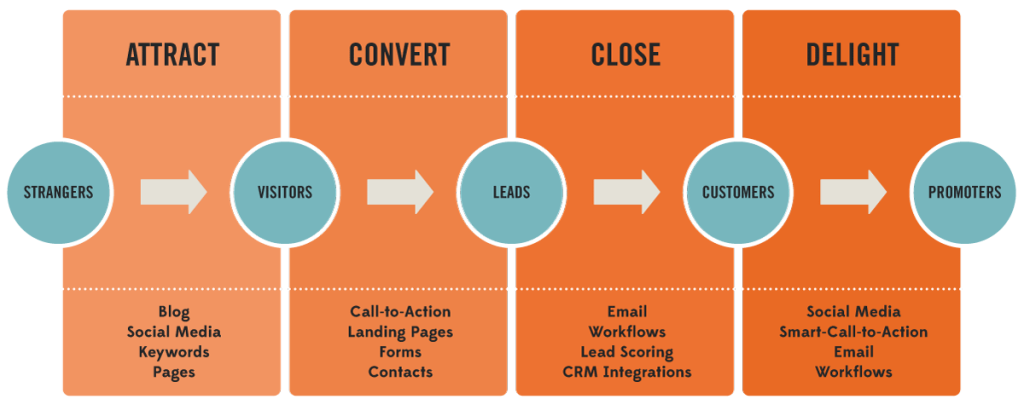
In our previous installment, Inbound Marketing 101: The Four Marketing Actions Part 1 – Attract Traffic to Your Website, you learned about the tools available to enable your business to get in front of your target audience and drive them to your website. In this post, we’ll explore step two of the process, how to convert traffic to leads.
Step Two: Convert
 Once you’ve attracted visitors to your website, the next step is to convert those visitors into leads. This process starts by gathering their contact information in order to engage them further and nurture them through the buyer’s pipeline/sales funnel. Conversion represents a “give and get” process by which you provide valuable information or materials in exchange for some contact information. It’s important to make sure that the information you request is balanced well with the materials you share but, at the very least, you’ll need to collect email addresses from your prospects in order to be able to move them further down the sales channel. Contact information represents the most valuable currency there is for the online marketer. In order for your site visitors to offer up that currency willingly, you will need to offer them something equitable. That “payment” comes in the form of content, such as worksheets, eBooks, whitepapers, coupons, or tip sheets – whatever information would be interesting and valuable to each of your personas. Offers vary by industry but virtually every business model has something that will resonate with its own personas to entice them to provide their contact information and convert from a visitor to a lead.
Once you’ve attracted visitors to your website, the next step is to convert those visitors into leads. This process starts by gathering their contact information in order to engage them further and nurture them through the buyer’s pipeline/sales funnel. Conversion represents a “give and get” process by which you provide valuable information or materials in exchange for some contact information. It’s important to make sure that the information you request is balanced well with the materials you share but, at the very least, you’ll need to collect email addresses from your prospects in order to be able to move them further down the sales channel. Contact information represents the most valuable currency there is for the online marketer. In order for your site visitors to offer up that currency willingly, you will need to offer them something equitable. That “payment” comes in the form of content, such as worksheets, eBooks, whitepapers, coupons, or tip sheets – whatever information would be interesting and valuable to each of your personas. Offers vary by industry but virtually every business model has something that will resonate with its own personas to entice them to provide their contact information and convert from a visitor to a lead.
Some of the most important tools in converting visitors to leads include:
- Calls-to-Action – Calls-to-action (CTAs) are on-page elements like graphics, buttons, or links that encourage your visitors to take action, like “Download a FREE eBook” or “Attend Our Webinar.” If your site doesn’t have the right CTAs or if they aren’t enticing enough, you will have a difficult time generating leads. The best calls-to-action are tailored to request a specific action well-aligned with the page content. Most of the time, you want to create a CTA that leads to a landing page or form, but cross-promotion of other interesting on-site materials can also be good strategies for driving engagement on your website. Ultimately, the goal is to collect information from your customers, however.
- Landing Pages – In most instances, when a website visitor clicks on a call-to-action, they should then be sent to a landing page. A landing page is a specialized page with information about a (usually free) content offer and a web-form into which the prospect submits contact information. Collecting this information allows your sales team to then leap into action to begin a conversation with the prospect. When website visitors fill out a form on a landing page for the first time, that visitor becomes a contact in your data system, and is then presented with the promised offer on the “thank you” page after the visitor submits the form.
- Forms – In order to collect information which allows visitors to become leads, they must fill out a form to send you their information. Keeping your forms as brief as possible and well-aligned with the “value” of the materials you provide in exchange is important. Many systems provide the opportunity to create “smart forms” to customize your form fields to collect different information each time a customer fills out a form. The key here is to make this step of the conversion process as easy as possible.
- Contacts – The best way to keep track of the leads you’re converting is leveraging a centralized marketing database. Having all your data in one place helps you track and assess every interaction you’ve had with your contacts – be it through email, a landing page, social media, or otherwise – and helps to optimize your future interactions with your personas.
Now that you have put your site to work as an inbound lead generating machine and converted your traffic to a lead, it’s time to close the deal and transform those leads into customers. Read how in our next inbound marketing post coming tomorrow: How to Close Sales.
Did you miss our other Inbound 101 series posts? Here are links to other articles:
